STEM is designed to deliver a complete financial model of a telecom operator’s business.
The unit costs and build constraints for the physical infrastructure of access,
switching and transmission must be considered alongside the additional costs of
software and spectrum licences, buildings, vehicles and human resources, which may
actually dominate the P&L.
From a business-planning perspective, some marketing costs are best estimated as
a (benchmarked) proportion of service revenues. Other overheads – such as the corporate
legal department – may present a fixed cost which should nevertheless be allocated
between services to ensure that the cost base for tariffs is accurately determined.
This straightforward article explains two simple and standard techniques for integrating
these costs into a classical network cost model. Please see our Web site for a previous
article discussing a range of typical drivers for various categories of overhead
cost.
Marketing costs as a proportion of service revenues
Consider a financial-planning exercise for a 3G network, including voice and data
services offered to both pre-paid and post-paid subscribers from a number of market
segments.
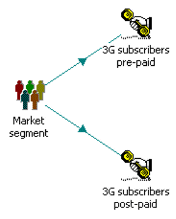
Simplified view of service elements
We may examine the projected take-up of pre-paid and post-paid subscribers according
to assumed penetration data, and measure the implied revenue potential.
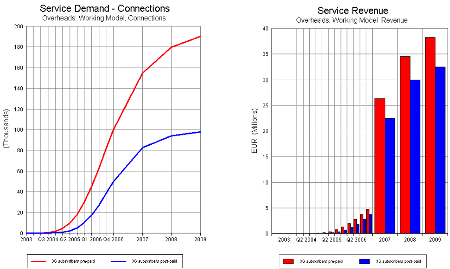
Projected take-up of subscribers and implied revenue potential
Our reference model, Equipment sharing in a UMTS roll-out, provides a detailed
methodology for the dimensioning and costing of carriers, base-stations, backhaul,
RNC, GGSN, SSGN, HLR and so on, which enables service revenues to be compared with
network costs. This is the point in model development where typically the focus
shifts to the question of overheads.
STEM has a simple but effective mechanism for driving overhead costs from service
revenues through the Annual Revenue basis for a Transformation. For the ‘3G subscribers
pre-paid’ Service above, the steps are in three stages as follows:
- First create a new Transformation and name this ‘Proportion of pre-paid revenue’.
- Hold the key and drag the Service onto the Transformation to define the Service
as the input.
- Double-click the newly created pink link to access the Transformation Input dialog.
- Change the Basis to Annual Revenue.

Defining the Transformation input basis
- Now right-click the Transformation icon and select Input and Transformation from
the icon menu. The Input and Transformation dialog is displayed.
- Right click to select the Multiplier field and type 0.05, so that the output of
the Transformation will be 5% of Annual Revenue.

Scaling the Transformation output
- Finally, create a new Resource and name this as ‘Marketing cost’.
- Right-click the Resource icon menu and select Unit Costs from the icon menu. The
Unit Costs dialog is displayed.
- Enter 1.0 for the Operations Cost (as the magnitude is inferred from the revenue).
- Hold the key and drag the Transformation onto the Resource to link the calculated
output to this Resource.

Reporting the calculation as a cost
When the model is run, STEM generates an operations cost for this Resource in equal
measure to 5% of revenue.
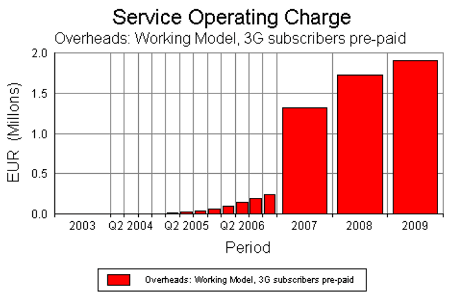
Forecast marketing costs as a proportion of service revenue
Multiple services
Of course you would want to use a similar method to drive marketing costs from all
Services, and the most compact technique would be to drive the cost from a single
Expression Transformation with a single proportion applied to the sum of all Service
revenues. However, the recommended approach is to add a separate Multiplier Transformation
for each Service so that you can vary the proportion by service type, e.g. having
a greater proportion for valuable post-paid subscribers where retention is a priority.

Varying proportions of revenue for marketing by service type
The extra Transformations can be readily copied from the first, and this approach
is also more scaleable as there is no limit to the number of Transformations which
can then be mapped onto the Marketing Cost Resource.
- Hold the key and drag the first Transformation onto the view background to create
a copy, and rename as ‘Proportion of post-paid revenue’.
- Hold the key and drag the second Service onto the new Transformation to define this
Service as the input. The basis of the copy is already set to Annual Revenue, and
the copy will have inherited the requirement for Marketing Cost.
- Right-click the new Transformation icon and select Input and Transformation from
the icon menu in order to enter an alternative value for the Multiplier field.
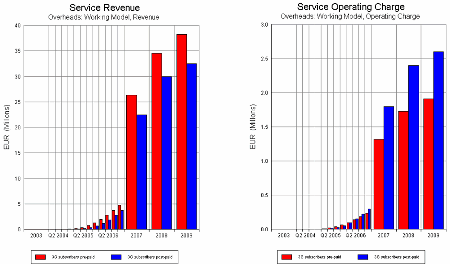
Revenues and marketing costs for pre-paid and post-paid subscribers
Fixed costs allocated between services
Our first example shows how to model a variable overhead linked to the projected
revenues from services. The other common requirement is to accommodate a known fixed
cost within a demand-driven STEM model so that economies of scale can be demonstrated
and so that the appropriate share of costs can be allocated between services. Once
again, this is readily achieved. The solution is obvious if the objective is stated
as being to model a fixed requirement for the corporate legal department function.
What you should do is employ an Expression Transformation whose output is defined
simply as 1.0. This can be used to drive a Resource, named ‘Legal department’, which
captures the salary overhead of the lawyers as an Operations Cost, say EUR1 million
per annum. (This can be generalised to cover the office and software costs, too.)

A fixed cost in a demand-driven model
The important thing is to link the various Services as multiple inputs to this Transformation
such that the relevant costs will be allocated. In this example, we have used the
default basis of Connections for the inputs, and defined the Cost Allocation basis
as Input Proportions so that the legal overheads are allocated per subscriber.
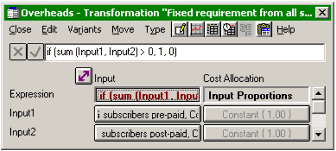
Legal overheads allocated per subscriber
As you will note from the illustration, we have in fact refined the expression such
that we only generate the legal costs once services are launched. In practice you
might want this cost to start earlier to cover the business start-up phase. The
following chart shows how the marketing costs grow to dominate as the subscriber
base expands and further effort is poured into customer acquisition and retention.
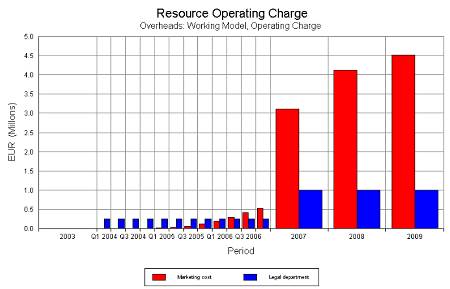
Variable marketing cost vs. fixed legal overhead